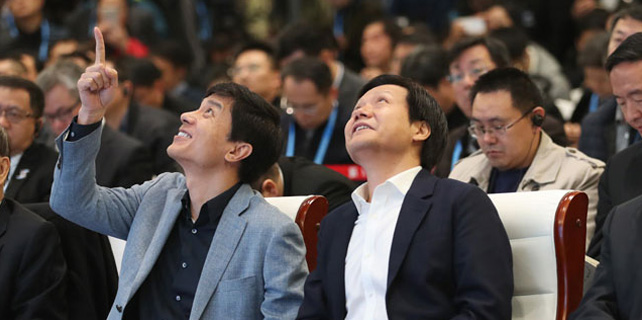Advancing RMB internationalization
Progress of Chinese currency is inevitable, and advantage should be taken of the current situation to further the cause
After a couple years of stagnation following the renminbi's unexpected devaluation in August 2015, the internationalization of the Chinese currency has recently gained momentum in tandem with the country's strong growth recovery.
A number of encouraging signs have surfaced. First, foreign investors' renewed interest in "Dim Sum" bonds, the RMB-denominated bonds issued in offshore markets, has lured more issuers to raise money in the niche bond market. Some new issuers of Dim Sum bonds are from other emerging markets, such as the Philippines and India, suggesting that the authorities' push for RMB internationalization has attracted increasing attention from advanced economies as well as China's emerging market peers.

Second, the total value of RMB deposits in Hong Kong has seen a gradual but steady recovery since it hit a six-year low in March last year. As of the end of 2017, it stood at 560 billion yuan ($88.9 billion; 72.7 billion euros; £64.3 billion), registering the first annual growth in the past three years. The recovery trend is significant, given that the value of offshore RMB deposits has long been regarded as an important indicator to gauge the extent of the internationalization of the Chinese currency. The resumed growth of offshore RMB deposits will largely boost foreign investors' sentiment.
Last but not least, Germany's central bank said in mid-January that it will include the RMB in its currency reserves, giving the Chinese currency's international stature a boost. Indeed, the European Central Bank already holds the yuan as a reserve currency, and the International Monetary Fund approved its inclusion in the Special Drawing Rights Basket in 2016. The German move has reflected the increasing acceptance of other countries' public sectors toward the RMB, which will sequentially encourage its use in the private sector worldwide.
Lurking behind the recent progress of RMB internationalization is the strong performance of the currency. Due in part to the unexpectedly sluggish dollar, the yuan has gained almost 10 percent over the past year. In the meantime, the Chinese authorities' clampdown on illegal capital flight and effective implementation of certain tightening measures under the capital account have turned outflows of China's balance of payments into inflows again. Moreover, the ongoing domestic financial deleveraging process has pushed up the level of market interest rates. As such, funds have been lured to flow back to China from other major economies where the zero policy rate can only offer modest returns for investors.
That said, the RMB seems to be in a sweet spot nowadays. The stabilized expectation of the exchange rate attracts funds to domestic financial markets for higher returns. Consequentially, fund inflows boost demand for the currency in the foreign exchange market and further anchor exchange rate expectations.
The tail wind from the stabilized exchange rate is welcome but past lessons told us to keep a cool head. Indeed, the momentum of RMB internationalization was even stronger in the period of 2010-15 when the currency's one-way expectation of appreciation spawned strong speculative demand for RMB assets in the onshore and offshore markets alike. However, after exchange rate reform in August 2015, this expectation largely gave way to two-way movement. Suddenly, dampened speculative demand evaporated market liquidity for the RMB and gave rise to several rounds of market turmoil. RMB internationalization was stuck in the doldrums in the following years until its recent rebound.
We firmly believe that the RMB still has a long way to go before it becomes a global currency in a real sense. The cyclical moves of the exchange rate could lead to variations in the progress of the RMB internationalization. But there is no reason for people to oscillate between states of excessive optimism and excessive pessimism. A crisis should never be wasted, and neither should a tail wind. The current benign external environment, in particular the combination of a weak dollar and strong global recovery, provides a new window to push forward some institutional changes so as to lay solid foundations for RMB internationalization on a sustainable basis. Moreover, some existing strategies of RMB internationalization need to be fine-tuned in parallel with the external environment.
First of all, despite other central banks' and sovereign funds' renewed interest in RMB assets, there remains great room for the currency to grow its market share in global foreign reserves. The IMF COFER database reports that RMB-denominated assets grew from the equivalent of $91 billion at the end of 2016 to $107 billion in the third quarter of 2017. Accordingly, the share market of RMB-denominated assets grew from 0.78 percent to 0.96 percent of the global total of foreign reserves. However, such a figure is not only below its designated weight in the Special Drawing Rights Basket (10.92 percent), but also lower than the shares of some non-SDR currencies, such as the Australian and Canadian dollars.
On the flip side, China's authorities can further the opening of the domestic financial market to accommodate the increasing global demand for its currency. In particular, the opening of the domestic bond market is crucial as other countries' appetite for the RMB-denominated assets mainly focuses on liquid "safe assets", such as bonds, rather than equity products. In this respect, Chinese regulators have already opened the domestic bond market to foreign institutional investors, including central banks, sovereign funds, insurance companies, pension funds, commercial banks and the like. Moreover, regulators on the Chinese mainland and in Hong Kong have recently launched a China Bond Connect program, which will provide an additional channel for global investors to invest in China's domestic bond market through Hong Kong, the prime offshore RMB business hub.
However, given the strong exchange rate and increasing appetite for the RMB-denominated assets, the one-way opening of domestic financial markets to global investors could introduce excessive appreciating expectations, which could further take a toll on the competitiveness of the export sector. Therefore, it is desirable for the authorities to relax some restrictive measures under the capital account to allow for capital outflows in certain forms so as to balance capital outflows and inflows for the purpose of exchange rate stabilization.
Second, China's authorities should take advantage of this opportunity to overcome some institutional constraints in the process of internationalizing the RMB. One conspicuous example in this respect is that the dollar continues to be the major denomination currency of the global commodity trade. Over the past decade, China has become the largest consumer of energy and commodities including copper, iron ore, aluminium, lead, zinc, nickel and rubber. However, for historical reasons, all major commodities are still settled in dollars, which hampers the use of the RMB in China's commodity trade with other partners.
To a certain extent, the current weak dollar has enabled the RMB to erode the greenback's market share in denominating commodities. The stable exchange rate of the RMB is expected to arouse the interest of commodity exporters in accepting it as a settlement currency. As such, the process of RMB internationalization is expected to be injected with new impetus.
In the same vein, RMB internationalization can also benefit from China's launch of the Belt and Road Initiative. The stable value of the currency will make it much easier for China's Belt and Road partners to use it in their project financing and trade settlement, which will further boost the market share of the RMB in the international monetary system.
It is only a matter of time before the "redback" gains global currency status. The authorities should deploy measured strategies to advance the currency's internationalization process and carefully guard against risks.
The author is chief economist for Asia at the Banco Bilbao Vizcaya Argentaria, a multinational Spanish banking group, and a senior research fellow at the International Monetary Institute of Renmin University of China. The views do not necessarily reflect those of China Daily.
(China Daily European Weekly 02/16/2018 page11)






















